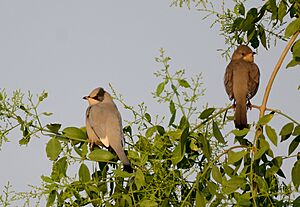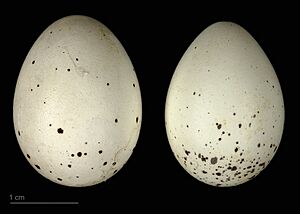Grey hypocolius facts for kids
The grey hypocolius (Hypocolius ampelinus) is a unique small bird. It's the only bird in its group, called Hypocolius, and it even has its very own bird family, the Hypocoliidae. This slender bird has a long tail and lives in dry, semi-desert areas. You can find it in northern Africa, Arabia, Afghanistan, Pakistan, and western India. These birds often fly in flocks and mostly eat fruits. They travel south for the winter, especially enjoying the fruits of the Salvadora persica plant during their journey.
Quick facts for kids Grey hypocolius |
|
|---|---|
 |
|
| Male (left) and female (Great Rann of Kutch) | |
| Conservation status | |
| Scientific classification |
Contents
Description
The grey hypocolius is a slim bird with a long tail. It has a small crest on its head and a thick, short bill with a hooked tip. Its soft, silky plumage (feathers) makes it look a bit like a waxwing.
Most of these birds are a plain grey or brownish-grey color. Male hypocoliuses have a black, triangle-shaped mask around their eyes. Their primary wing feathers are black with white tips, and their tail has a black band at the end. Adult birds are about 19 to 21 centimeters long.
When a hypocolius gets excited, the feathers on its head stand up. They fly in a straight line, not bouncing up and down. When they hop through bushes, they can look like a babbler. Their legs are short and strong, with rough scales. You can see small bristles near the base of their bill, and their nostrils are small and oval.
Bird Family Tree
For a long time, scientists weren't sure how the grey hypocolius was related to other birds. Some thought they might be linked to bulbuls or shrikes.
However, studies now suggest they are related to waxwings. A recent study from 2019 showed that the grey hypocolius belongs to a group of birds that includes the palmchat, waxwings, silky-flycatchers, hylocitrea, and the extinct Hawaiian honeyeaters. The hypocolius family (Hypocoliidae) is a close relative of the Hawaiian honeyeaters.
Where They Live and Their Home
The grey hypocolius lives across the Middle East. They breed in areas like Iraq, Iran, Afghanistan, Pakistan, and Turkmenistan. In winter, they mostly move to the coasts near the Red Sea and Persian Gulf in Arabia, including Bahrain.
Sometimes, they wander to places like Turkey, Israel, Egypt, and Oman. They visit the Kutch and Jamnagar regions of western India regularly in winter. Some have even been seen as far south as Kihim, near Bombay.
These birds prefer woodlands and scrublands in dry or semi-dry areas. They especially like river valleys near deserts. You can also find them in places with irrigation and trees, like palm groves and gardens, and along sea coasts.
Behaviour
The grey hypocolius is a shy bird. If it feels threatened, it will quickly fly into thick bushes and stay very still until the danger passes. Its flight is strong and direct. These birds often form flocks, especially in winter, and they roost (sleep) together in groups.
Reproduction
The breeding season for the grey hypocolius in Arabia is usually in June or July. They build a deep, cup-shaped nest. It is lined with hair and soft fluff. Nests are often placed on the leaves of a date palm tree, about 3 to 5 feet off the ground. Both the male and female birds help build the nest.
A female hypocolius usually lays four eggs. The eggs are a dull white color with blotches. The parents take turns sitting on the eggs for about 14 to 15 days until they hatch.
Feeding Habits
Grey hypocoliuses quietly search for food among leaves, in clusters of trees, palm groves, and orchards. They rarely come down to the ground. While they might eat some insects, their main diet is fruits and berries. This includes Real mustard fruits, mulberries, figs, and dates. In zoos, they have been known to eat bread.
Calls
The most common sound the grey hypocolius makes is a series of squealing notes that go down in pitch, or kleeeu whistles. They also make scolding chirps.
Conservation Status
The grey hypocolius has a large range where it lives. Its population is not shrinking quickly, and there are many of them. Because of this, the IUCN Red List considers its conservation status to be of "least concern". This means they are not currently at risk of extinction.
Because it's the only bird in its unique family, many birdwatchers are very keen to see the grey hypocolius.
Gallery




